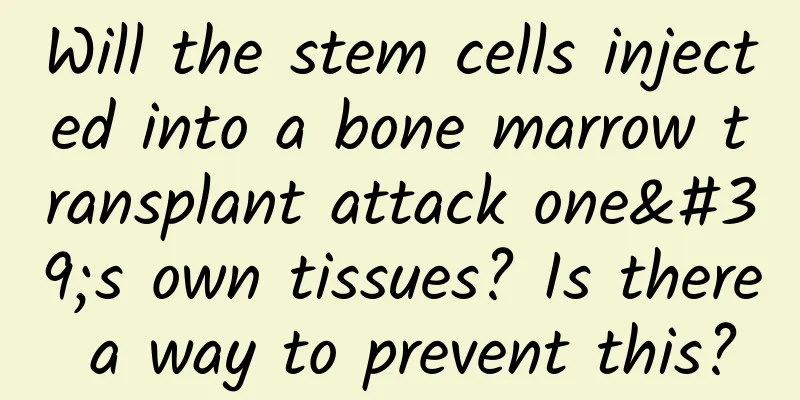Will the stem cells injected into a bone marrow transplant attack one's own tissues? Is there a way to prevent this?

|
Author: Huang Xiaojun, Chief Physician, Peking University People's Hospital Reviewer: Duan Yanlong, Chief Physician, Beijing Children's Hospital, Capital Medical University Bone marrow transplantation is the process of infusing a normal donor's bone marrow into the patient's peripheral blood to enable the patient to establish normal hematopoietic and immune functions. It is mainly used to treat malignant blood diseases, such as acute leukemia, lymphoma, myeloma, etc. It can also be used to treat some bone marrow failure diseases, such as severe aplastic anemia and hereditary thalassemia. There are two types of bone marrow transplantation: autologous bone marrow transplantation and allogeneic bone marrow transplantation. Figure 1 Original copyright image, no permission to reprint One of the main reasons for the failure of allogeneic bone marrow transplantation is the occurrence of graft-versus-host disease, which is a reaction between the graft and the recipient's tissues, leading to tissue and organ damage. GVHD is divided into acute GVHD and chronic GVHD. Generally speaking, the incidence of severe GVHD is about 10%, which is very scary. 1. What is the mechanism of graft-versus-host disease in bone marrow transplantation? The pathogenesis is the immunological reaction caused by the difference in tissue antigens between the donor and the recipient. In allogeneic bone marrow transplantation, whether it is from parents or siblings, since they are different individuals, their tissue antigens are different. The T cells that are infused are a type of immune cell that has anti-tumor and anti-viral effects. After entering the recipient's body, because they are incompatible with the recipient's tissues, they think that the recipient's tissues are foreign and not their own, and will kill them like tumors or viruses. Figure 2 Original copyright image, no permission to reprint In the past, it was believed that bone marrow transplantation could only be performed when the human leukocyte antigens matched, and transplantation could not be performed if the matching points did not match, because graft-versus-host disease was very serious. Now that haploid transplantation has been successful, the human leukocyte antigen factor has become less important. It was originally believed to be the main cause of graft-versus-host disease, but now it seems unimportant. From a clinical perspective, the older the transplant donor is, the more severe the host-versus-host disease may be; if the donor is a female, the possibility of host-versus-host disease is also greater. 2. What are the symptoms of graft-versus-host disease in bone marrow transplantation? There are three main manifestations: the first is rash; the second is diarrhea; and the third is liver damage, which is caused by antigens damaging and destroying the skin tissue, intestinal tissue, and liver tissue. Skin rash is the earliest or most common manifestation of graft-versus-host disease, often appearing on the palms and behind the ears first, but now there are more and more atypical rashes. If it is just a rash, it is okay; if it develops into a rash all over the body, it may be very uncomfortable; if it is more severe, it may develop into exfoliative dermatitis, which is easy to get infected and poses a threat to life. Therefore, if a rash appears within a certain period of time after bone marrow transplantation, graft-versus-host disease should be considered first and a differential diagnosis should be made. Figure 3 Original copyright image, no permission to reprint Diarrhea is also very common, and usually progresses very quickly. Initially, watery stools occur once or twice a day, but after one or two days this may increase to seven or eight times, or even more than ten times. In severe cases, blood in the stool may occur, and severe blood in the stool may even be fatal. Liver function damage, increased transaminase and bilirubin, severe cases can also lead to liver failure. GVHD can have a single symptom, such as only a rash, or only diarrhea, or only liver damage, but most cases have two or three or more symptoms. Based on clinical manifestations, clinicians can basically determine whether graft-versus-host disease has occurred. If it is difficult to determine, skin biopsy, colonoscopy, and liver puncture can be performed. 3. Early detection and early intervention of graft-versus-host disease after bone marrow transplantation are very important After bone marrow transplantation, it is unknown when graft-versus-host disease will occur, and it is usually not specific when it occurs. Therefore, biochemical tests should be performed at least once a week within 100 days after bone marrow transplantation. If there are abnormalities, tests can be performed twice a week. Regular follow-up and monitoring should be carried out. When it reaches the chronic graft-versus-host disease stage, it usually develops more slowly. It is generally recommended to check every two to three weeks or one month after the chronic stage, and once every three to four months after one year. For matched graft-versus-host disease, we usually add immunosuppressants before the transplant, such as cyclosporine A and tacrolimus. According to different transplant types, there are different plans and different combinations to reduce the incidence of graft-versus-host disease. For mismatched graft-versus-host disease, that is, haploid transplantation, the incidence of severe graft-versus-host disease is about 10%, and prevention is the key. In the early stage of graft-versus-host disease, when the skin damage is at grade I or II, intervention treatment will have a much higher success rate. Treatment is divided into first-line treatment and second-line treatment. First-line treatment is hormones, usually 1mg or 2mg of hormones. If the treatment is ineffective after three to seven days, it will enter the second-line treatment. The effectiveness of first-line treatment is usually only 50-60%, and most of them will progress quickly and enter the second-line treatment. Therefore, to prevent graft-versus-host disease, early detection and early intervention are very important. |
>>: Low or high immune function may lead to this malignant tumor!
Recommend
Does a woman's body temperature rise during menstruation?
Women's body temperature will change througho...
Can I drink Tieguanyin tea during menstruation?
Tieguanyin tea is a kind of tea that many people ...
What is the reason for miscarriage within one month of pregnancy?
Pregnant women are a special group. For the healt...
【Creative Cultivation Program】In fact, it is your stomach that controls your brain!
Author: Chen Wen Reviewer: Associate Professor Ta...
What are the standards for surgical masks? How to test whether disposable masks are qualified?
The wide variety of disposable masks on the marke...
What tests should be done before curettage?
Under normal circumstances, a series of condition...
Just half a month after the menstrual period came again
What's wrong with my menstrual period? Menstr...
How many normal fetal movements are there in 5 months?
Fetal movement is closely related to the physical...
How to solve the problem of wife's sexual indifference
Some people notice that their wives are sexually ...
Can I get pregnant if I have irregular menstruation?
Irregular menstruation is one of the common disea...
What are the nutritional values of golden jujube? How to eat golden jujube
There are many ways to eat golden thread jujube. ...
Can beer and liquor be drunk together? How to check the alcohol content of beer
The raw materials of beer are: barley, brewing wa...
My wife cried in pain for the first time
For girls, it is normal that the first sexual int...
I didn't know I had sex ten days into my pregnancy.
When you just get pregnant, the placenta is not y...









